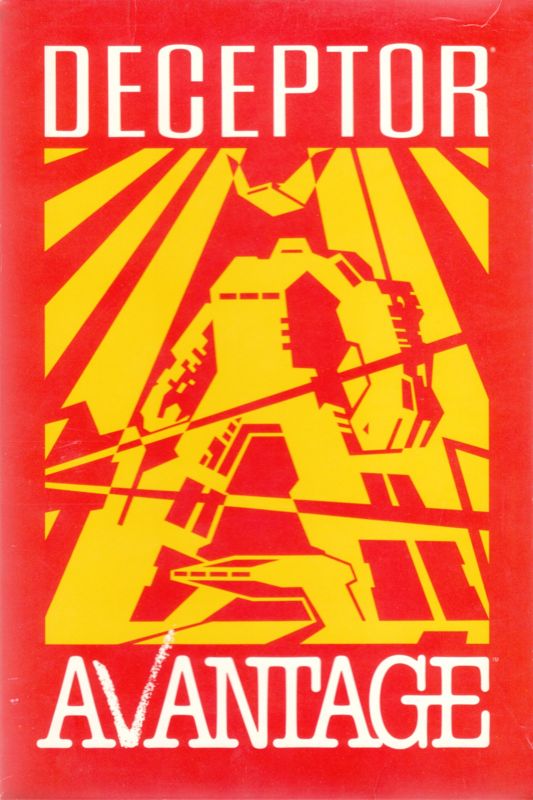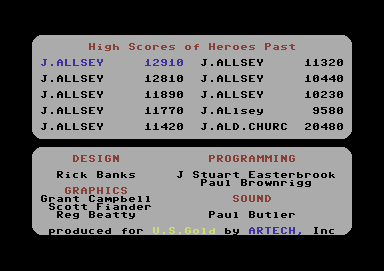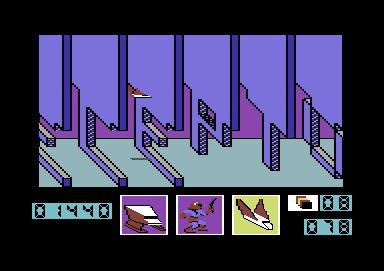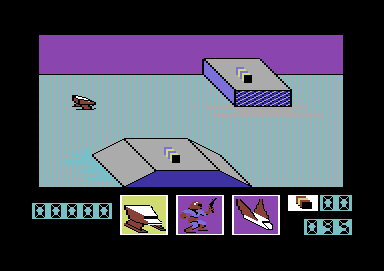Retro Replay Review
Gameplay
Deceptor delivers a fast-paced, arcade-action experience set across four distinct corridors, each bristling with its own set of perils and puzzles. From the moment you start, you’re immediately thrown into the thick of it, tasked with shepherding your Deceptor through winding paths teeming with hostile creatures. The isometric perspective provides a clear view of upcoming obstacles, while the time limit for each corridor adds an exhilarating pressure to keep you moving.
The transformation mechanic is the heart of Deceptor’s gameplay. You can switch at will between your base Deceptor form, a land vehicle, and an air vehicle, each of which offers unique traversal advantages. As a land vehicle, you can plow through low obstacles and maintain steady ground speed, whereas the air vehicle grants access to elevated platforms—but beware, any contact with ground terrain automatically reverts you back to the land form unless you toggle again with your fire button.
Each corridor culminates in a guardian battle, which shifts the gameplay into a slightly different rhythm. Upon reaching the gate, you’re auto-transformed into your humanoid form and must engage the guardian with limited ammunition. Scavenging ammo units during your corridor run becomes essential, as you’ll need enough firepower to chip away at the guardian’s health before time runs out.
The overall pacing of the game is brisk and unforgiving, rewarding players who master the timing of their transformations and who plan routes to collect vital ammo pickups. A single mistake—be it an ill-timed vehicle swap or a momentary lapse in concentration—can force a restart of the corridor, keeping the challenge level consistently high.
Graphics
Visually, Deceptor’s 2D-isometric style is both nostalgic and polished, invoking memories of classic arcade titles while benefiting from modern sprite work. The corridors are richly detailed, featuring metallic walls, glowing energy conduits, and animated hazards that lend a sense of depth and dynamism to the environments.
The transformation animations stand out in particular. When switching between your humanoid Deceptor and the land or air vehicles, the fluidity of the morphing sequence impresses, making each form change feel weighty and responsive. Subtle particle effects accompany these transitions, reinforcing the sci-fi ambiance.
Enemies and guardians are distinct in design, allowing you to quickly identify threat types. Lesser corridor inhabitants range from darting mechanical critters to hovering drones, each animated with purposeful movement patterns. Boss guardians, in their own chambers beyond the gate, boast larger sprites and intricate attack animations, giving each guardian confrontation a cinematic flair.
The color palette strikes a fine balance between dark, industrial tones and vibrant neon highlights, ensuring clarity of foreground action against the backdrop. Background music and sound effects further amplify the visual presentation, with engine roars during vehicle runs and crackling laser fire during guardian fights syncing perfectly with what you see on screen.
Story
Deceptor’s narrative may begin minimally, but it effectively lays the groundwork for your journey. As the titular Deceptor, you’ve been schooled by your elders in the ancient art of transformation, destined to uncover your fate by conquering the four corridors. This simple premise provides a clear motivation for each level and each form you adopt.
Throughout the game, flavor text snippets and environmental cues flesh out the world. Scattered data pads hint at a long-lost civilization that first mastered the transformative arts and foresaw a threat only you, the Deceptor, could thwart. While the story doesn’t overwhelm you with lore dumps, it peppers in enough worldbuilding to keep you invested.
Reaching each gate and facing the guardians feels like a rite of passage, tying the gameplay loop back into the narrative. You can sense the ancient ritualistic importance of these trials, making each successful corridor conquest more than just another checkpoint—it feels like stepping closer to your ultimate destiny.
The story’s emphasis on transformation isn’t just mechanical—it’s thematic. As you evolve through forms and outwit each guardian, you embody the very principle your elders imparted: mastering change to shape your future. By the time you stand before the final gate, the culmination of your journey feels earned and meaningful.
Overall Experience
Deceptor excels at delivering a tight, challenging arcade-action experience that rewards skillful play and strategic form-switching. Its blend of timed runs, vehicle transformations, and guardian battles keeps the gameplay varied and engaging from start to finish. If you thrive on precision and relish a tough but fair challenge, Deceptor will scratch that competitive itch.
The learning curve can be steep, especially as corridor layouts become more labyrinthine and enemy patterns grow complex. However, the sense of progression—from mastering the toggle between land and air forms to efficiently collecting ammunition—provides a gratifying feedback loop that encourages repeated attempts.
While the game doesn’t offer branching paths or RPG-style upgrades, its pure arcade focus is a strength rather than a limitation. Each corridor is designed for tight, replayable runs, and speedrunners will find plenty of depth in optimizing routes, transformation timing, and ammo usage to shave precious seconds off their best times.
Overall, Deceptor stands out as an inventive homage to classic arcades, wrapped in a sleek sci-fi skin. Its straightforward premise, polished visuals, and adrenaline-fueled corridors combine into an experience that both seasoned retro gamers and newcomers to the genre can appreciate. Prepare to transform, adapt, and conquer your destiny—Deceptor is ready to test your reflexes and strategic mind at every turn.
 Retro Replay Retro Replay gaming reviews, news, emulation, geek stuff and more!
Retro Replay Retro Replay gaming reviews, news, emulation, geek stuff and more!









Reviews
There are no reviews yet.